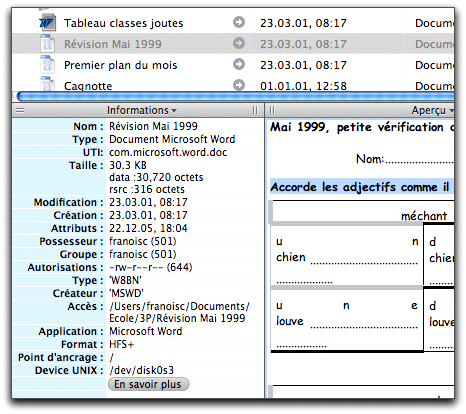


#Filexaminer code
The IconFamily code started out as a small experiment that yielded a modest bit of code that has since found its way into a gratifying number of applications. get and set the elements of an icon family in convenient, Cocoa-compatible.copy icon data to and from the scrap (pasteboard).assign an icon family as a file or folder's custom icon resource, so it will appear in Finder views.create a multi-representation icon family from any arbitrary NSImage.Its main purpose is to enable Cocoa applications to easily assign custom file icons from NSImage instances. “IconFamily” is a Cocoa/Objective-C wrapper for Mac OS X Icon Services’ “IconFamily” data type. This is silly and inconsistent (I "jumped" right to "Home". It appears that I am still looking "ten levels deep" in the directory structure, even though my "focus" is at three levels deep (ie, seven columns to the left of what's visible on screen). Us forgetful users often need details about the underlying document to remind us what file name we should choose for the document.Ħ) It is possible (esp with the default window size in TextEdit) for the panel to completely obscure the document beneath, and since you can not see the underlying doc's bottom-right corner you can't resize it.ħ) "Hide Extension" has no noticable effect and gives no clue as to what it really should be doing.Ĩ) Not so much specifically the "Save As" panel, but more the general mechanics of Column View: if I'm ten directories deep and change to "Home" (three levels deep) I am presented with a blank screen (multiple empty columns) and a bottom scroll bar scrolled all the way to the right. And even then you are constrained by a predefined maximum (2x the min column size).Ģ) You can not overwrite an existing file without retyping its file name in full.ģ) You can not make a derivative of an existng file name without retyping the name in full.Ĥ) Resizing the panel resizes it in two directions at once, which runs counter to the convention of resizing only one direction in the rest of the OS (a panel issue, but Save inherits it)ĥ) The panel obscures the document beneath it. But let me count the most obvious:ġ) To see longer folder names you have to make the dialog box smaller. IMHO, a very bad UI design on the save dialog, in countless ways. Can you get any more of "This is a really really really long folder name" to display than just "This is a really really really"? And that's only if you shrink the dialog box down so that only two columns can fit, then grow it until just before it changes to three columns. Try to save the new document (File/Save). That width is too narrow to view a really long folder name.Įxperiment: Create a folder called "This is a really really really long folder name". The complaint is simple: the column view in the save boxes has some pre-determined "width" which it keeps each column at.

#Filexaminer full
But in any case it is a good idea.Īctually, no, the column width is not based on the width of the longest folder name (I have some long folder names which come from the same code base being used cross-platform, and no matter how wide I make the dialog box the columns "pop" back down to size before I can see the full folder names!) If that option in that particluar app is efficient or not, I do not know, since I have not feel the need to use it so far. I appreciate apps such as PGP which include an "Uninstall" option in their application's menu.
#Filexaminer install
Well, besides ~/Library/Preferences it seems like it has been a long time since you looked at folders such asĮxcluding applications that create their preferences/user data in none of the folders above, such excluding, of course, the applications that after granting them root access install items inside the /System/ folder, such as Norton or whatever other, or, better, in hidden Unix folders such as /usr/local/bin/, in which case prepare to unwrap your fingers for Terminal use or reach some third party app.Īdmittedly, applications' traces are much more localizable than in whatever flavor of Windows, but still OS X made a headache of what in OS 9 was a breeze.


 0 kommentar(er)
0 kommentar(er)
